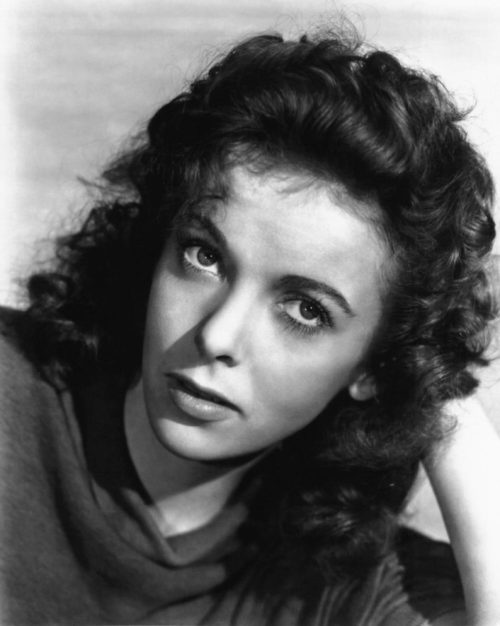
Ida Lupino (1918-1995) was a prominent film actress and director in Hollywood in the 1940s and 1950s. In a 48-year career, which began in Britain in 1931, she appeared in 59 movies and directed eight others.
As an actress, she was something of a femme fatale, projecting a gutsy persona and playing tough yet vulnerable characters.
In her capacity as a director, she gravitated toward socially relevant films dealing with such topics as rape, bigamy and out-of-wedlock pregnancy.
From August 4 until September 2, the Toronto International Film Festival will showcase her in a retrospective, Ida Lupino: Independent Woman, at the TIFF Bell Lightbox.
A preview:
In Raoul Walsh’s taut drama, They Drive By Night, Lupino has a secondary role as a scheming wife intent on seducing Joe Fabrini (George Raft), one of her husband’s employees. Fabrini and his brother, Paul (Humphrey Bogart), work for Ed Carlsen (Alan Hale), the owner of a fleet of trucks. Carlsen’s much younger wife, Lana (Lupino), can’t stand the sight of him, although he seems to be an amiable, good-humored, generous fellow. When she senses an opportunity to eliminate Carlsen from the picture and thereby enhance her prospects of catching Fabrini in her net, she takes the plunge
Long before these events transpire, the focus of this 1940 Warner Brothers’ film is the highly competitive trucking industry.
Sleep-starved due to their overly long hours on the road, the Fabrinis are California truck drivers struggling to earn a living. They’re behind in their truck payments, and a mean-spirited employer who owes them the princely sum of $300 for recent jobs is stiffing them.
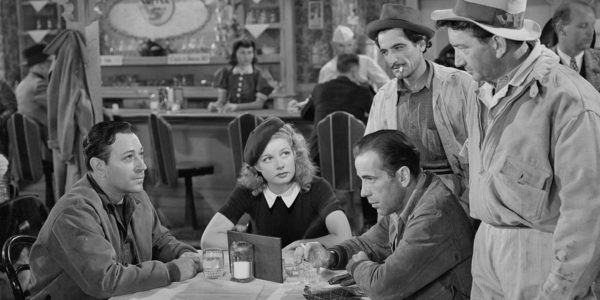
One night, as they’re hauling apples to Los Angeles, they crash into a tree and damage their vehicle, thereby imperilling their livelihood. Decamping to a roadside restaurant frequented by truckers, Joe meets Cassie (Ann Sheridan), a hard-boiled red-headed waitress who’s really a sweetheart. They’ll meet again under different circumstances, and romantic sparks will fly.
To fend off the possibility of insolvency, Joe devises a new strategy. Cutting out the middle man, he buys fresh produce from the farmer rather than hauling it to market for a sub-contractor. He sells cases of fresh lemons to a wholesaler in Los Angeles and makes a handsome profit. He’s discovered the secret of success, but fate intervenes and ruins his path to profitability.
Mired in financial troubles, Joe accepts Carlsen’s job offer as a manager. He and Cassie, who are engaged to be married, have a lot to celebrate. Lana, however, is still determined to win over Joe, come what may.
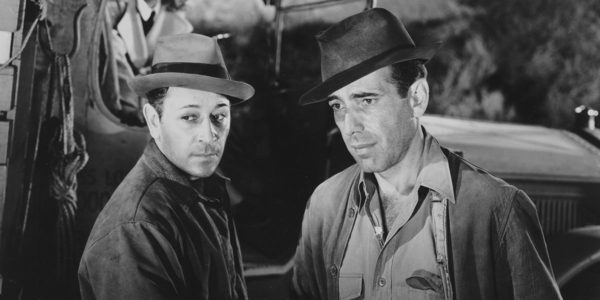
The film, ably directed by Walsh, moves along at a fast clip and is never less than entertaining due to stellar performances from an accomplished cast. Lupino is by turns seductive and menacing. Raft and Bogart are in fine form.
The dialogue is snappy and quaintly dated. “You dames are sure screwy,” says Joe. Or: “I had a swell time.” Or: “Take it easy, fella.” And when he needs to make an out-of-town phone call, he tells the operator, “Give me long distance.”
They Drive By Night is a relic from a distant era, a Hollywood time capsule brimming with vim and vigor.
A year after They Drive By Night hit movie theatres, Raoul Walsh came out with High Sierra (1941), starring Bogart as a hardened criminal and Lupino as his clingy girlfriend.
Bogart portrays Roy Earle, a bank robber who’s released from prison thanks to a pardon arranged by his patron and friend, Big Mac (Donald McBride). Nearing retirement, Big Mac wants to pull off one last job before he exits from the scene. He’s chosen Earle, a consummate pro, to carry out the heist at a fancy hotel high in the rugged mountains of California. His assistants are two inexperienced criminals, Babe (Alan Curtis) and Red (Arthur Kennedy). A hotel reception clerk, Louis Mendoza (Cornel Wilde), has been roped into the robbery as an inside man.
En route to the rustic lodge where he’ll stay until further instructions, Earle meets a nice elderly couple and their vivacious granddaughter, Velma (Joan Leslie). He takes a shine to them, but he’s particularly interested in Velma, who’s hobbled by an untreated clubfoot.
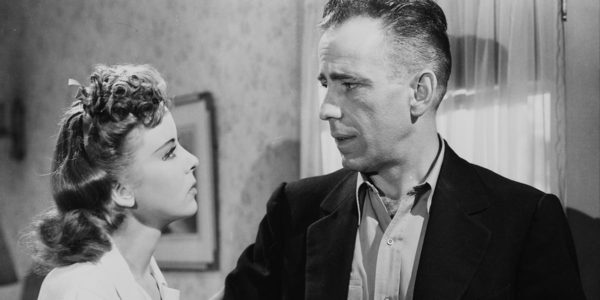
At the lodge, he meets Marie (Lupino), a former nightclub dancer. Marie, Babe’s girlfriend, is immediately attracted to Earle. Being infatuated with Velma, Earle virtually ignores Marie. Paying Velma and her grandparents a visit in Los Angeles, he offers to pay for her surgery.
The robbery goes fairly smoothly as Earle and his two accomplices relieve the hotel of money and jewelry. As planned, Earle delivers the jewelry to Big Mac. But Babe and Red abscond with the cash. In short order, Earle fatally shoots Kranmer (Barton MacLane), a crooked cop who works for Big Mac.
Having been rejected by Marie, Earle draws closer to Marie, who becomes his loyal partner in crime. Promising to meet her soon after dropping her off at a bus station, he drives toward the mountains with his share of the proceeds from the “fenced” jewelry. Earle has a price on his head, a $10,000 reward having been issued for his arrest.
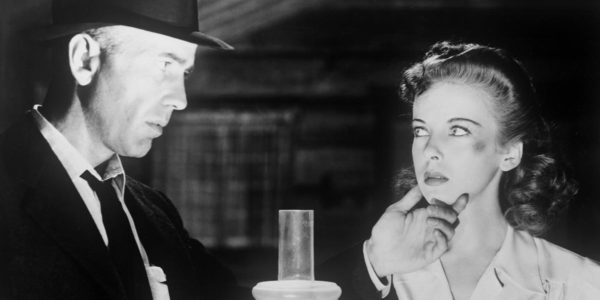
As police cruisers and cops on motorcycles close in on him, he abandons his car and run for it. “Come and get me,” he shouts, taunting the police in the valley.
High Sierra, briskly directed by Walsh, is a top-notch film noir crime thriller. Bogart is astonishingly good as a pugnacious gangster with a heart of gold, and Lupino is equally effective as a gang moll who stands by her man.
Deftly directed by Lupino, The Hitch-Hiker (1953) is an excellent example of late film noir. Minimalist in conception and execution, this thriller stars Edmond O’Brien and Frank Lovejoy as two buddies whose car is hijacked at gunpoint by a petty criminal and murderer. The hijacking occurs as Roy Collins (O’Brien) and Gilbert Bowen (Lovejoy) drive to Baja California, Mexico, for a fishing holiday.
The hijacker, Emmett Myers ((William Talman), is clearly disturbed. Perhaps he’s a psychopath. Myers, having killed several people already, is a threat to all motorists. Unluckily, Collins and Bowen are his newest victims.
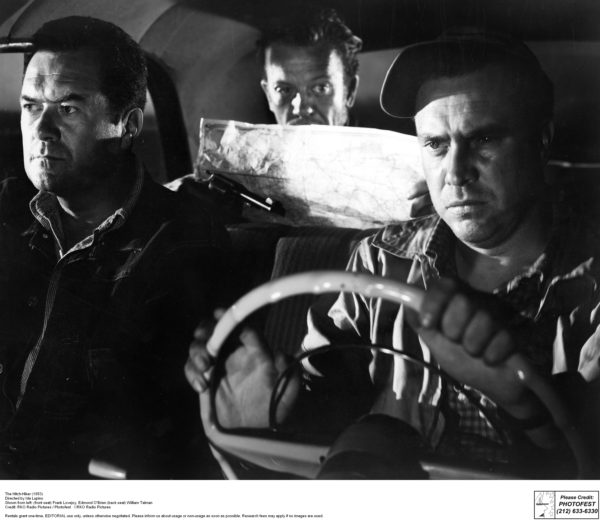
Myers, sitting in the back seat holding a revolver, orders them to drive to a town 500 miles away. It will be an unpleasant journey through scenic mountainous and desert terrain. Myers alternatively torments and pokes fun at them. Collins and Bowen put up with his abuse stoically.
More than a day into the journey, Myers threatens the pair. “You guys are going to die,” he says. “It’s just a question of when.”
Collins, growing demoralized, suggests that they overpower Myers and end their ordeal. Bowen urges caution. Nonetheless, they leave clues of their whereabouts. By now, American and Mexican authorities have launched a manhunt for the missing men.
This is a straight-forward film with a predictable ending, but it sizzles with excitement as it heads toward its denouement. The cinematography is first-rate and the musical score is tingling. O’Brien, Lovejoy and Talman acquit themselves with aplomb.
As B-movies go, The Hitch-Hiker is one of the better ones in its class, a feather in Ida Lupino’s cap.